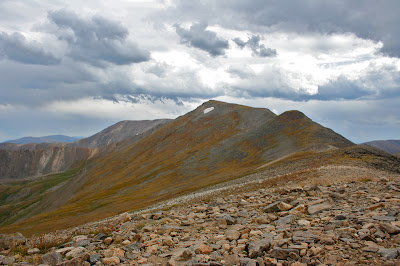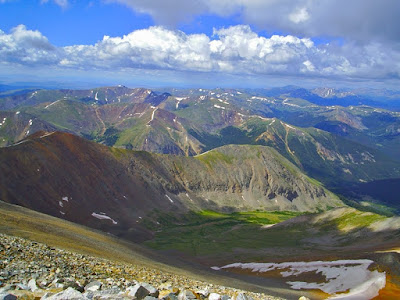Distance: 7.5 miles round trip
Elevation: 11,670 ft - 13,794 ft
Elevation Gain: 2,124 ft (net) ~2,900 ft (cumulative)
Date Hiked: 10 September, 2012
Dogs: Off leash
Bathroom at the Trailhead: Yes
Tags: #coloradooutdoors, #peakbagging, #
gearguide
 |
| View from the summit of Square Top Mountain |
Square Top Mountain (13,794 ft) is a high 13er directly across from
Mt. Beirstadt off of Guanella Pass Colorado. The only trail on this journey is the approach to its base, via
Square Top Lakes. From the lakes on, climbing Square Top Mountain it is a tundra and talus bushwhack. This is great fun for those who like to have the mountains to themselves but less fun to those who consider going off trail an invitation to a thousand painful deaths.
 |
| A rough schematic of the route |
 |
| The trailhead. Square Top Mountain can be seen in the distance. |
The other challenging feature of Square Top Mountain, besides the terrain, is the weather. Guanella Pass is a thunderstorm magnet and I have come close to experiencing painful death number 46: the gods are pissed at YOU... at both
Silver Dollar Lake as well as
Square Top Lakes. It is amazing how motivated you can be to get the hell out of dodge when the heavens open up above treeline. So, rather than just the perennial early start, I would recommend saving Square Top Mountain for one of those rare, cloudless days when you can spend all day on the mountain without fear of divine retribution. Bushwhacking is time consuming and the mountain scenery alluring so give yourself time to enjoy the experience.
 |
| Heading across the first valley |
The trailhead for Square Top Mountain is located on Guanella Pass itself. Park in the west side lot, which is the overflow for
Mt. Beirstadt. You can see the east face of Square Top Mountain from the parking area. As you follow the trail for two miles to lower Square Top Lake, the route will descend 100 ft into a valley before ascending and descending again over a several small ridges that block the view of the lake from the trail. The only vegetation in this tundra environment is Willows and the occasional stunted Sub-alpine Fir.
 |
| Approaching the lake |
 |
| Lower Square Top Lake |
Once you see the lake, continue past it on the left for another two tenths of a mile to a trail junction up a short slope. This junction serves upper Square Top Lake (to the right), the South Park 600 Trail (to the left), and Square Top Mountain (straight up). There is an actual sign pointing up the mountain. From this point on, however, you are on your own. How you reach the summit is up to you.
 |
| Trail sign pointing up the mountain |
 |
| Looking up to the first shelf |
The funny thing about bushwhacking is what looks good on the topo map and what looks good on the ground can be two different things. It seemed straight forward to head up the mountain in the direction pointed to by the trail sign, but after the first shelf, which was covered in quartz rocks, I realized I would be better off heading southwards and upwards at an angle. I actually ran into two hikers coming down that way and they gave me the best piece of advice. "Go around the mountain to the south and stay well below the summit ridge until you have to pop up", they said. This turned out to be the way to go.
 |
| Approaching the first shelf |
 |
| Looking down from the first shelf |
While taking an angled traverse is hard on the ankles, I found there were plenty of flat spots that one could traverse between to give them a bit of a break. Once I got around the mountain I could see the summit ridge stretching off into the distance. The summit of Square Top Mountain might be square, but it is far from flat. Much like fins on the back of a dragon, there are larges piles of boulders placed periodically along the spine of the ridge. These would be a tedious, mind numbing experience if taken all at once. Don't walk that summit ridge.
 |
| Looking up at the initial angled traverse |
 |
| A close up of the tundra |
As it was, a large river of talus on the southern slope made me pop up sooner than expected. I was not worried, however, because I thought the large pile of boulders just above was the summit. Oh foolish mortal! There were at least three more false summits (e.g. dragon fins) between me and the summit. Unless you are a member of Cirque du Soliel, and can bounce effortlessly from jagged rock to jagged rock, you will find this last bit of the route time consuming. Another good reason to wait until a sunny day!
 |
| Looking back down from the southern side of the mountain |
 |
| Just below the summit ridge |
Because the summit of Square Top Mountain is so long, the views are not as dramatic as you find on other peaks. You have to walk around to look over the sides. Since I never trust the weather on Guanella Pass, I decided not wander but headed down after a quick snack. This was a prudent choice...by the time I reached the car, the Gods had awoken. Woe to the few hikers I passed heading upwards towards Square Top Lakes. At least today they would be pissed at someone else.
 |
| I thought that bump on the horizon was the summit. The summit is actually multiple bumps ahead. |
 |
| That bump on the horizon is still not the summit. |
My decent of the mountain was totally different than the ascent. Things look different coming down as well! I ended up finding some cairns and followed them but they came very close to the sheer cliff of the cirque that contains Upper Square Top Lake. Once again, the fun of bushwhacking is finding your own way. To be safe, however, I would bring along a GPS, a topo map, and a cell phone. At one point I phoned home with my GPS coordinates since no one would have a clue where to starting looking for me on the broad slopes well away from the "obvious route".
 |
| Finally, the summit comes in view |
I saw a couple of
Mountain Goats below me on the ascent and a large gorilla-sized
Marmot below the lakes. I think being cuddled by an overly large marmot is painful death #238 but I will have to check the list and get back to you.
 |
| The author on the summit |
Square Top Mountain is not the first mountain I would recommend in Colorado. There are certainly many nicer ones.
Mt. Flora across I-70 on Berthoud Pass is a must do. Still, if you are like me and hate the fact that there are peaks nearby that you have not visited, you will find Square Top Mountain beckoning at some point.
 |
| Heading back down |





























































